
Make Your Puppy Feel At Home
Even before you pick up your puppy, have your home ready. The first few days are critical for your success with your pet and your pet's success with you. Moving into a new home is stressful, and your puppy may forget any housebreaking already learned. Be ready to keep your pet in a room where cleaup will be easier. Dog-proof the area where your pet will be staying, putting up baby gates, removing rugs and potted plants, taping electrical cords to the wall or floor, and storing household chemicals on high shelves.Train your dog from the first moment you have him, making sure you use clear and consistent vocabulary with your dog.
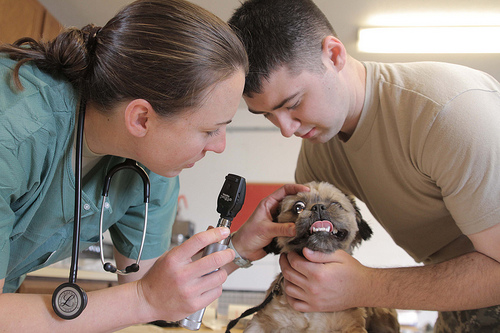
Pick The Right Veterinarian
A veterinarian is your dog's second-best friend. If your friends and neighbors have had a good experience with a veterinary clinic, check it out. On your first visit, note whether the office and the exam areas are clean, spacious, and well-organized. Ask how many vets are on staff, or if the vet works solo, how he or she covers vacation time. Ask whether the vet has technicians on staff, and how the clinic monitors pets during overnight stays. Find out whether your vet accepts insurance, makes referrals, and handles pain management, and if the practice has specialized expertise in treating rescue dogs, if you are adopting a rescue puppy.
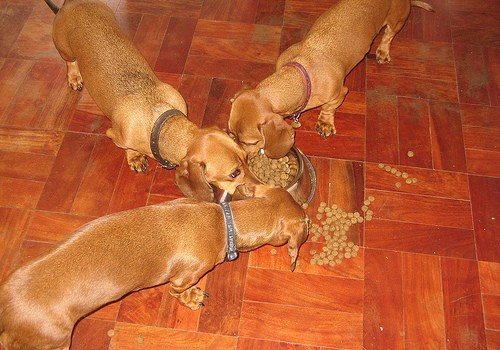
Food And Water Bowls
Many new pet owners overlook the fact that not just pets will feed from pet food and water bowls. Visiting pets, raccoons, skunks, birds, squirrels, rats, and mice are all attracted to pet food and water. Be sure to place bowls where your dog can reach them with a minimum of competition, and take them inside at night. Placing a pet food bowl in the middle of the floor discourages nighttime visits by mice. An elevated metal bowl discourages visits by bugs. Plastic bowls should be avoided because they can be chewed and spring leaks, and some pets are allergic to them.
- Important notification about information and brand names used in this slideshow!
- Photo courtesy of Paul Jacobson by Flickr : www.flickr.com/photos/pejrm/1667623898/
- Petco Advice Center. Choose a Pet Bowl. https://www.petco.com/Shop/ShoppingGuides/petco_ChooseDogBowl_ShoppingGuideID_21_Nav_288.aspx. Accessed 15 February 2014.

Puppy Needs A Place To Sleep
Every puppy needs a comfortable bed. Measure your dog from tail to nose to make sure the bed is long enough for stretching out. If your puppy likes to hide under the bed, then a bed with a hood may be more comfortable for both your pet and you at night. Make sure any pet bed you choose is machine washable, and wash regularly to keep fleas and other insects in control. Be aware that larger animals will require thicker cushions, as will older animals with joint problems. If you see the bed flattening out, replace it with thicker cushions to ensure your pet's joint health.
- Important notification about information and brand names used in this slideshow!
- Photo courtesy of fltmech98 by Flickr : www.flickr.com/photos/33754830@N05/3268000409/
- Overstock Dot Com. Five Tips on Choosing a Pet Bed. http://www.overstock.com/guides/top-5-tips-on-choosing-a-pet-bed. Accessed 15 February 2014.
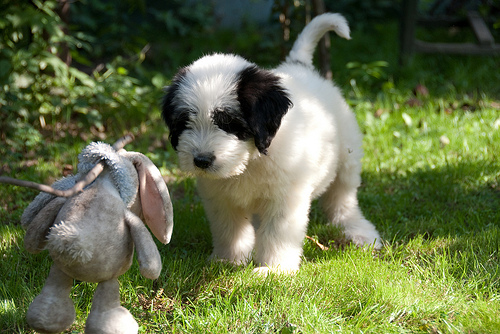
Toys For Puppy
Puppies love toys, but people toys usually don't work out well for our canine friends. Dogs need dog toys, not people toys. Avoid stuffed toys that can fall apart releasing irritating fibers or pieces of styrofoam that could cause choking. Be careful with squeakers. Either your dog will like the squeaker, and squeak all the time, or your dog won't like the squeaker, and will remove it before you will. Some puppy toys are designed for intelligent inquisitive dogs: Puzzle balls will roll around until eventually the treat inside rolls out. Stuffies are fine if your dog doesn't like to tear things apart. Dogs usually love rawhide chew toys, but be careful. Bits of the hide can accumulate in the dog's digestive tract and cause intestinal blockage.
- Important notification about information and brand names used in this slideshow!
- Photo courtesy of Mihai Bojin by Flickr : www.flickr.com/photos/mihaibojin/3955739737/
- The Dog Guide. Choosing the Best Dog Toys. http://www.dogguide.net/choosing-dog-toys.php. Accessed 15 January 2014.
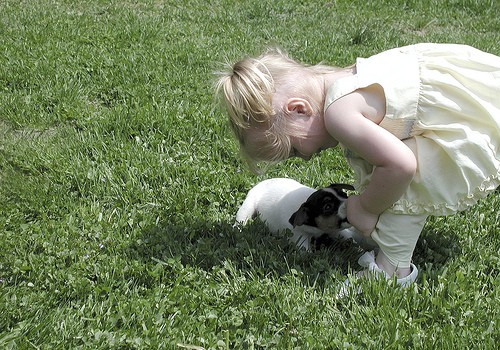
Introduce Puppy to Your Child Or Children
Introducing your dog to your newborn? The first time your dog and your baby meet, have everybody but mom and baby go into the house first so the dog can express the usual excitement at seeing his or her people, and then bring in the child. Keep the atmosphere calm. Then make sure the dog also gets attention when baby is around. You don't want to have to deal with a jealous dog. Introducing your children to your dog? Usually bringing home a puppy is a cause for joy and excitement all around. Just don't get too loud or too physical--pulling lips and riding puppy like a pony is not a good idea--and make sure your puppy feels safe.
- Important notification about information and brand names used in this slideshow!
- Photo courtesy of Linda Garcia by Flickr : www.flickr.com/photos/lcphotog/293070845/
- ASPCA. Introducing your dog to your child. http://www.aspca.org/pet-care/virtual-pet-behaviorist/dog-behavior/introducing-your-dog-your-new-baby. Accessed 15 February 2014.
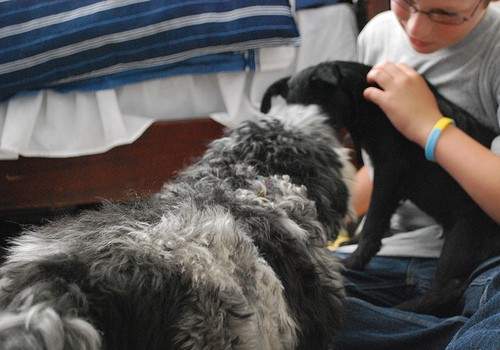
Introduce Old Pet And New
In the USA, 75 million dogs live in just 45 million homes. About 1/3 of all dog owning families have more than one dog, and in most cases, there was an older dog that had to be introduced to a newer dog. Your pet may not be especially enthusiastic to meet competition. Leave your current dog at home when you pick up your new pet. You don't want to put them both in the car and hope for the best! Then introduce your pets on neutral territory, not in your home, so your older pet does not feel threatened. Allow for a few minutes of sniffing when dogs first meet, and then keep the atmosphere easy. Don't force them to pay attention to each other. If acrinony does not break out, take your pets home but avoid tensions until they get to know each other.
- Important notification about information and brand names used in this slideshow!
- Photo courtesy of Fred Rockwood by Flickr : www.flickr.com/photos/freeloosedirt/2637629676/
- ASPCA Virtual Pet Behavior Guide. http://www.aspca.org/pet-care/virtual-pet-behaviorist/dog-behavior/introducing-your-dog-new-dog. Accessed 15 February 2014.

Regular Bathing
it's best to make a habit of regular bathing of your puppy from the very beginning. Keeping your dog clean reduces flea infestations, lowers the risk of allergies, and preventing the spread of fleas and insects from your puppy to the rest of your pets and even to you. Especially if your dog spends a lot of time outdoors, regular bathing is a must. Use warm water and a mild, neutral doggie shampoo. Neem shampoos are especially helpful for insect bites and mange. After you bathe your puppy, put your clothes in the washer and do a warm cycle wash to kill any bugs that may have jumped off, and take a shower of your own. Combing your dogs hair daily will also prevent accumulation of fleas, but make sure to take your own shower after you comb your dog.
- Important notification about information and brand names used in this slideshow!
- Photo courtesy of T Frey by Flickr : www.flickr.com/photos/toreajade/49856654/
- Millan C. Caesar's Way: Successfully Bathing Your Dog. http://www.cesarsway.com/dogcare/grooming/How-to-Successfully-Bathe-Your-Dog. Accessed 15 February 2014.
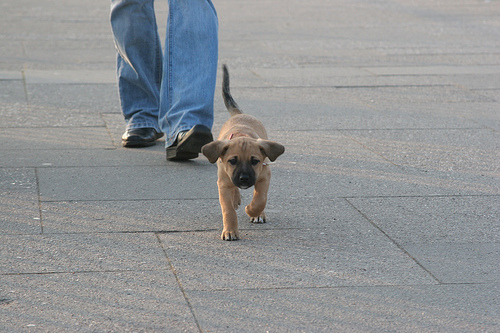
Take Your Puppy For A Walk
Walking the dog is the highlight of the day for many dogs and for many owners. Walking gives your dog a chance to exercise, to reconnect with the world of sound and scent, and to pee and to poop. Curbing your dog is a must in any neighborhood--if you are new to the USA, you need to understand that few things will irritate your neighbors more than failing to do so. Unless you have access to a leash-free dog park, you will need to keep your dog on a leash when you go out for a walk. Walk in front of your dog, not behind. Use a short leash for greater control. Carry a few treats to reward your dog for good behavior on its walk. Keep leading, even when you get home. And feed and water your dog after your walk, so you can treat them as a reward for good behavior.
- Important notification about information and brand names used in this slideshow!
- Photo courtesy of blizzy78 by Flickr : www.flickr.com/photos/blizzy/111145859/
- Millian C. Cesar's Way: 6 Tips for Mastering the Dog Walk. http://www.cesarsway.com/training/thewalk/6-Tips-for-Mastering-the-Dog-Walk. Accessed 15 February 2014.
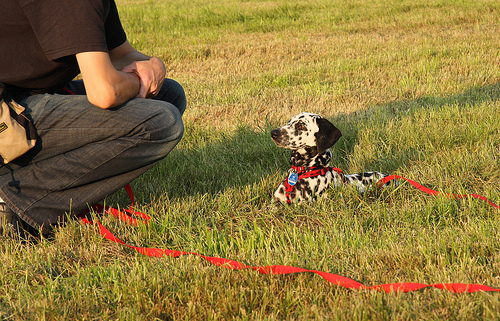
Train Your Puppy
When should you start training a puppy? Immediately! Puppies are hard wired to be part of a pack. If it's just you and your puppy, you take the role of pack leader. You need to be confident, clear, direct, and decisive from the very beginning. Puppies are hard wired not to toilet in their dens. Provide a familiar place for your dog to "go" every day and make sure they get to go there at about the same time. Walk your dog. Don't let your dog walk you. Always be the leader in every activity and your dog will be a loyal member of your pack.
- Important notification about information and brand names used in this slideshow!
- Photo courtesy of Maja Dumat by Flickr : www.flickr.com/photos/blumenbiene/6023283800/
- Millian C. Starting Your Puppy Off Right. http://www.cesarsway.com/dog-training/the-basics/starting-your-puppy-off-right. 15 February 2014.




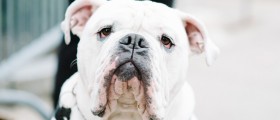
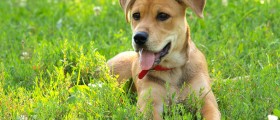
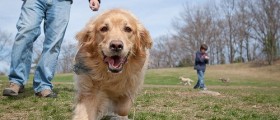
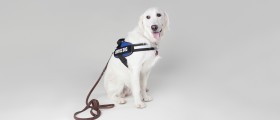



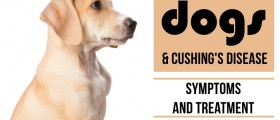
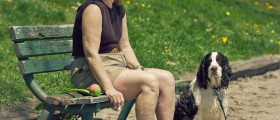
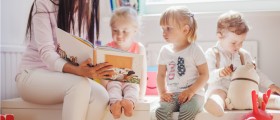
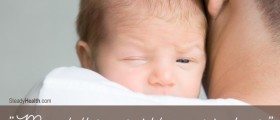




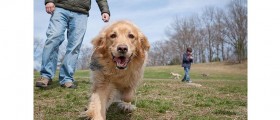

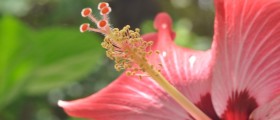

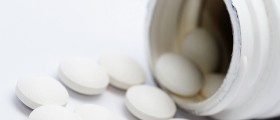
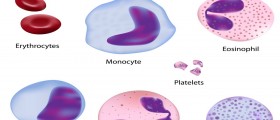
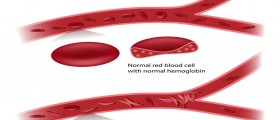
Your thoughts on this
Loading...